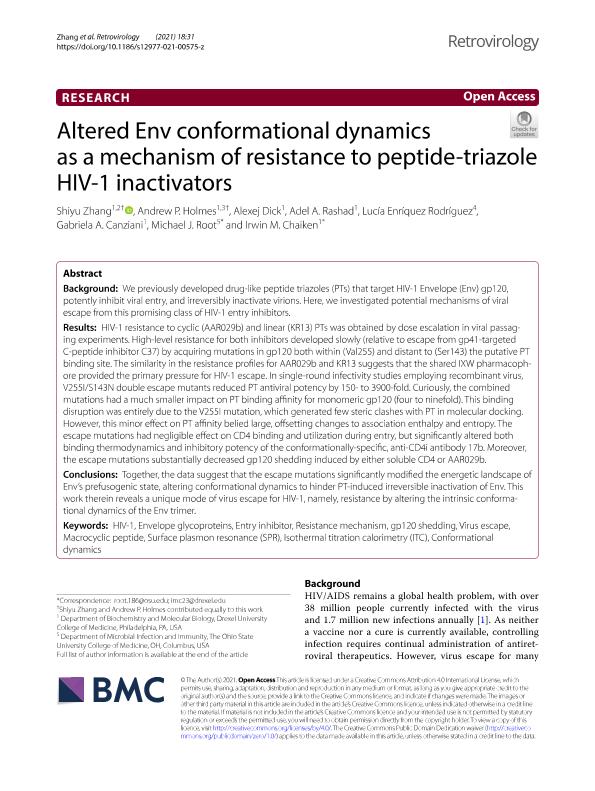Artículo
Altered Env conformational dynamics as a mechanism of resistance to peptide-triazole HIV-1 inactivators
Zhang, Shiyu; Holmes, Andrew P.; Dick, Alexej; Rashad, Adel A.; Enríquez Rodríguez, Lucía; Canziani, Gabriela Alicia ; Root, Michael J.; Chaiken, Irwin M.
; Root, Michael J.; Chaiken, Irwin M.
 ; Root, Michael J.; Chaiken, Irwin M.
; Root, Michael J.; Chaiken, Irwin M.
Fecha de publicación:
12/2021
Editorial:
BioMed Central
Revista:
Retrovirology
ISSN:
1742-4690
Idioma:
Inglés
Tipo de recurso:
Artículo publicado
Clasificación temática:
Resumen
Background: We previously developed drug-like peptide triazoles (PTs) that target HIV-1 Envelope (Env) gp120, potently inhibit viral entry, and irreversibly inactivate virions. Here, we investigated potential mechanisms of viral escape from this promising class of HIV-1 entry inhibitors. Results: HIV-1 resistance to cyclic (AAR029b) and linear (KR13) PTs was obtained by dose escalation in viral passaging experiments. High-level resistance for both inhibitors developed slowly (relative to escape from gp41-targeted C-peptide inhibitor C37) by acquiring mutations in gp120 both within (Val255) and distant to (Ser143) the putative PT binding site. The similarity in the resistance profiles for AAR029b and KR13 suggests that the shared IXW pharmacophore provided the primary pressure for HIV-1 escape. In single-round infectivity studies employing recombinant virus, V255I/S143N double escape mutants reduced PT antiviral potency by 150- to 3900-fold. Curiously, the combined mutations had a much smaller impact on PT binding affinity for monomeric gp120 (four to ninefold). This binding disruption was entirely due to the V255I mutation, which generated few steric clashes with PT in molecular docking. However, this minor effect on PT affinity belied large, offsetting changes to association enthalpy and entropy. The escape mutations had negligible effect on CD4 binding and utilization during entry, but significantly altered both binding thermodynamics and inhibitory potency of the conformationally-specific, anti-CD4i antibody 17b. Moreover, the escape mutations substantially decreased gp120 shedding induced by either soluble CD4 or AAR029b. Conclusions: Together, the data suggest that the escape mutations significantly modified the energetic landscape of Env’s prefusogenic state, altering conformational dynamics to hinder PT-induced irreversible inactivation of Env. This work therein reveals a unique mode of virus escape for HIV-1, namely, resistance by altering the intrinsic conformational dynamics of the Env trimer.
Archivos asociados
Licencia
Identificadores
Colecciones
Articulos(ICT - MILSTEIN)
Articulos de INST.DE CS. Y TECNOLOGIA "DR. CESAR MILSTEIN"
Articulos de INST.DE CS. Y TECNOLOGIA "DR. CESAR MILSTEIN"
Citación
Zhang, Shiyu; Holmes, Andrew P.; Dick, Alexej; Rashad, Adel A.; Enríquez Rodríguez, Lucía; et al.; Altered Env conformational dynamics as a mechanism of resistance to peptide-triazole HIV-1 inactivators; BioMed Central; Retrovirology; 18; 1; 12-2021; 1-18
Compartir
Altmétricas



